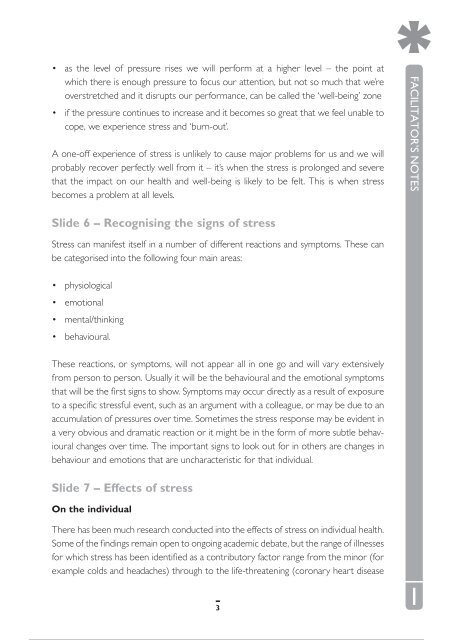Contents - CIPD
Contents - CIPD
Contents - CIPD
Create successful ePaper yourself
Turn your PDF publications into a flip-book with our unique Google optimized e-Paper software.
which there is enough pressure to focus our attention, but not so much that we’reoverstretched and it disrupts our performance, can be called the ‘well-being’ zone cope, we experience stress and ‘burn-out’.A one-off experience of stress is unlikely to cause major problems for us and we willprobably recover perfectly well from it – it’s when the stress is prolonged and severethat the impact on our health and well-being is likely to be felt. This is when stressbecomes a problem at all levels.FACILITATOR’S NOTESSlide 6 – Recognising the signs of stressStress can manifest itself in a number of different reactions and symptoms. These canbe categorised into the following four main areas: These reactions, or symptoms, will not appear all in one go and will vary extensivelyfrom person to person. Usually it will be the behavioural and the emotional symptomsthat will be the first signs to show. Symptoms may occur directly as a result of exposureto a specific stressful event, such as an argument with a colleague, or may be due to anaccumulation of pressures over time. Sometimes the stress response may be evident ina very obvious and dramatic reaction or it might be in the form of more subtle behaviouralchanges over time. The important signs to look out for in others are changes inbehaviour and emotions that are uncharacteristic for that individual.Slide 7 – Effects of stressOn the individualThere has been much research conducted into the effects of stress on individual health.Some of the findings remain open to ongoing academic debate, but the range of illnessesfor which stress has been identified as a contributory factor range from the minor (forexample colds and headaches) through to the life-threatening (coronary heart disease31A free sample chapter from Stress by Robertson Cooper. Published by the <strong>CIPD</strong>. © 2008 <strong>CIPD</strong>.All rights reserved; no part of this excerpt may be reproduced, stored in a retrieval system, or transmitted in anyform or by any means, electronic, mechanical, photocopying, recording or otherwise without the prior writtenpermission of the publishers or a licence permitting restricted copying in the United Kingdom issued by theCopyright Licensing Agency.If you would like to purchase this product please go to www.cipd.co.uk/bookstore
















